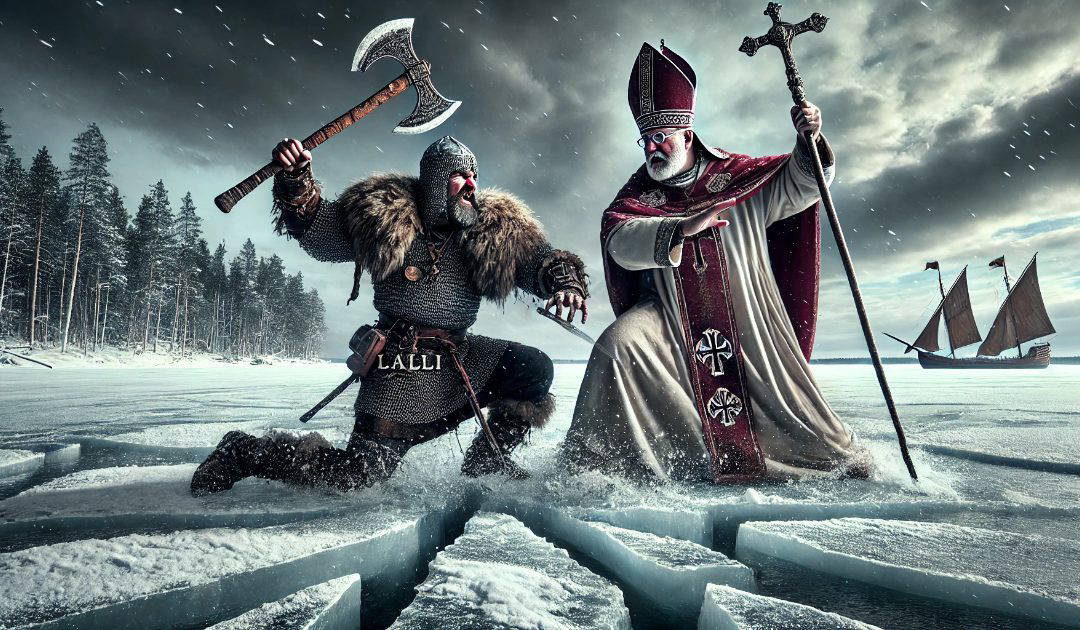I like a mystery, and I’ve found one today. The On This Day website tells that it was on 20th January 1156 Lalli slayed the English Crusader Bishop Henry. According to the tales, Lalli was a freeholder who opposed the Christianization efforts led by Bishop Henry in the early 12th century. The conflict between Lalli and the bishop is emblematic of the resistance some local populations had against the imposition of Christianity by foreign missionaries.
The most famous account describes how Bishop Henry traveled to Finland to spread Christianity and establish the church. During his mission, he encountered Lalli, who was angered by the bishop’s presence and the changes he represented. The legend states that Lalli confronted Bishop Henry on the ice of Lake Köyliönjärvi, where a violent confrontation ensued. In this encounter, Lalli is said to have slain the bishop with an axe, marking a significant moment in the folklore surrounding the early Christianization of Finland.
However the only Bishop Henry who was an English Crusader I have found is Henry of Blois. Henry was born around 1096, the fourth son of Stephen II, Count of Blois, and Adela of Normandy. Adela was the daughter of William the Conqueror, connecting Henry to the Norman royal dynasty. Intended for the Church, Henry was educated at the Abbey of Cluny in France, a center of monastic reform. This upbringing instilled in him a deep appreciation for art, architecture, and ecclesiastical discipline, which would later shape his career.
In 1126, Henry was appointed Abbot of Glastonbury, England’s wealthiest abbey, giving him control over vast lands and resources. His appointment was a reflection of his family’s growing influence, as his elder brother, Stephen, was a favored nephew of King Henry I of England. Henry’s tenure at Glastonbury allowed him to amass wealth and establish his reputation as a capable administrator. In 1129, Henry was elected Bishop of Winchester, the second wealthiest diocese in England. This dual role as abbot and bishop made him one of the most powerful churchmen in England. His close relationship with his brother Stephen became pivotal in 1135 when Stephen seized the English throne after the death of Henry I, despite the latter’s daughter Matilda being the designated heir.
Henry played a critical role during Stephen’s reign, which was marked by a civil war against Empress Matilda and her supporters. As one of Stephen’s chief advisors, Henry used his wealth and influence to support the king’s cause, including fortifying Winchester and mobilizing troops. However, his loyalties wavered during the conflict. In 1141, he briefly supported Matilda when she gained the upper hand, reflecting his pragmatic approach to maintaining power and influence regardless of the shifting political landscape.
Henry was a patron of the arts and a key figure in the Romanesque architectural revival in England. At Glastonbury, he initiated major building projects, including the construction of an opulent abbey church. As Bishop of Winchester, he expanded Winchester Cathedral and commissioned magnificent decorative works. He also played a role in the broader intellectual life of the Church. He supported reforms and aligned himself with the papacy, though he often prioritized his political ambitions over purely spiritual concerns. Henry’s legacy includes his vision of a powerful, independent Church that could act as a counterbalance to secular authority. After Stephen’s death in 1154 and the ascension of Henry II, Bishop Henry of Blois saw his political influence diminish. He retired to Cluny in 1158 and focused on ecclesiastical matters until his death in 1171.
So the mystery remains, who was the Bishop Henry slain by Lalli in 1156 on the ice in Finland? Was it a merely a folk story? Was the Bishop Henry in Finland an imposter, or did the real Bishop Henry die in Finland, and an imposter take his place in that presumably chaotic period between Stephen’s death and Henry retiring to Cluny? Oh, no need to tell me that spectacles weren’t developed until the 13th century in Italy, that’s the problem with using AI for illustrations.

